
Alessandro di Mariano di Vanni Filipepi, better known as Sandro Botticelli or simply Botticelli, was an Italian painter of the Early Renaissance. Botticelli's posthumous reputation suffered until the late 19th century, when he was rediscovered by the Pre-Raphaelites who stimulated a reappraisal of his work. Since then, his paintings have been seen to represent the linear grace of late Italian Gothic and some Early Renaissance painting, even though they date from the latter half of the Italian Renaissance period.
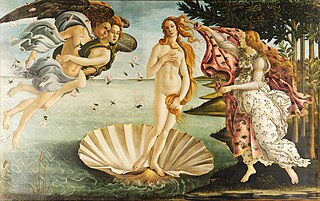
The Birth of Venus is a painting by the Italian artist Sandro Botticelli, probably executed in the mid 1480s. It depicts the goddess Venus arriving at the shore after her birth, when she had emerged from the sea fully-grown. The painting is in the Uffizi Gallery in Florence, Italy.

Filippino Lippi was an Italian painter working in Florence, Italy during the later years of the Early Renaissance and first few years of the High Renaissance.

Andrea Mantegna was an Italian painter, a student of Roman archeology, and son-in-law of Jacopo Bellini.
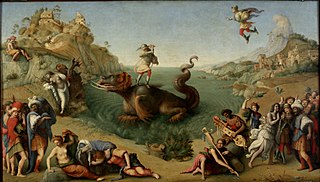
Piero di Cosimo, also known as Piero di Lorenzo, was an Italian painter of the Renaissance.

Antonio del Pollaiuolo, also known as Antonio di Jacopo Pollaiuolo or Antonio Pollaiuolo, was an Italian Renaissance painter, sculptor, engraver, and goldsmith, who made important works in all these media, as well as designing works in others, for example vestments, metal embroidery being a medium he worked in at the start of his career.

Adriaen Isenbrandt or Adriaen Ysenbrandt was a painter in Bruges, in the final years of Early Netherlandish painting, and the first of the Dutch and Flemish Renaissance painting of the Northern Renaissance. Documentary evidence suggests he was a significant and successful artist of his period, even though no specific works by his hand are clearly documented. Art historians have conjectured that he operated a large workshop specializing in religious subjects and devotional paintings, which were executed in a conservative style in the tradition of the Early Netherlandish painting of the previous century. By his time, the new booming economy of Antwerp had made this the centre of painting in the Low Countries, but the previous centre of Bruges retained considerable prestige.

Filippo Lippi, also known as Lippo Lippi, was an Italian painter of the Quattrocento and a Carmelite priest. He was an early Renaissance master of a painting workshop, who taught many painters. Sandro Botticelli and Francesco di Pesello were among his most distinguished pupils. His son, Filippino Lippi, also studied under him and assisted in some late works.

Simonetta Vespucci, nicknamed la bella Simonetta, was an Italian noblewoman from Genoa, the wife of Marco Vespucci of Florence and the cousin-in-law of Amerigo Vespucci. She was known as the greatest beauty of her age in Italy, and was allegedly the model for many paintings by Sandro Botticelli, Piero di Cosimo, and other Florentine painters. Some art historians have taken issue with these attributions, which the Victorian critic John Ruskin has been blamed for promulgating.
The decade of the 1480s in art involved some significant events.
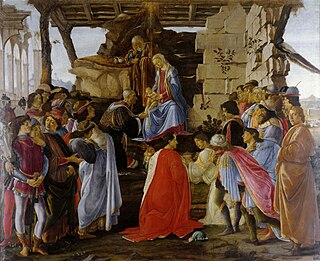
The Adoration of the Magi is a painting by the Italian Renaissance master Sandro Botticelli. Botticelli painted this piece for the altar in Gaspare di Zanobi del Lama's chapel in Santa Maria Novella around 1475. This painting depicts the Biblical story of the Three Magi following a star to find the newborn Jesus. The image of the altarpiece centers on the Virgin Mary and the newborn Jesus, with Saint Joseph behind them. Before them are the three kings who are described in the New Testament story of the Adoration of the Magi. The three kings worship the Christ Child and present him with gifts of gold, frankincense and myrrh. In addition, the Holy Family is surrounded by a group of people who came to see the child who was said to be the son of God.

The Last Communion of Saint Jerome is a painting by the Italian Renaissance master Sandro Botticelli, finished around 1494–1495. It is now in the Metropolitan Museum of Art, in New York City.
Events from the year 1557 in art.
Adam and Eve is the title of two famous works in different media by Albrecht Dürer, a German artist of the Northern Renaissance: an engraving made in 1504, and a pair of oil-on-panel paintings completed in 1507.
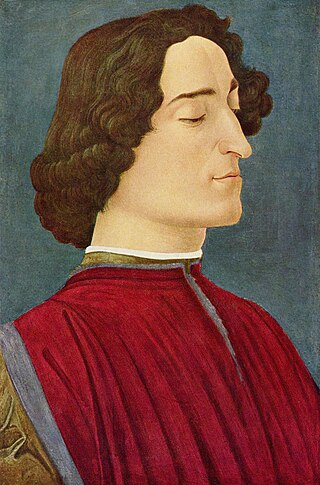
The Portrait of Giuliano de' Medici is a painting of Giuliano de' Medici (1453-1478) by the Italian Renaissance painter Sandro Botticelli, probably painted soon before Giuliano was assassinated in the Pazzi conspiracy in 1478. It belongs to the Berlin State Museums, and is in the Gemäldegalerie, Berlin.

Venus and Mars is a panel painting of about 1485 by the Italian Renaissance painter Sandro Botticelli. It shows the Roman gods Venus, goddess of love, and Mars, god of war, in an allegory of beauty and valour. The youthful and voluptuous couple recline in a forest setting, surrounded by playful baby satyrs.

The Calumny of Apelles is a panel painting in tempera by the Italian Renaissance painter Sandro Botticelli. Based on the description of a lost ancient painting by Apelles, the work was completed in about 1494–95, and is now in the Uffizi, Florence.

Primavera, is a large panel painting in tempera paint by the Italian Renaissance painter Sandro Botticelli made in the late 1470s or early 1480s. It has been described as "one of the most written about, and most controversial paintings in the world", and also "one of the most popular paintings in Western art".

Portrait of a Man is a c. 1478 painting by the Italian Renaissance painter Domenico Ghirlandaio (1449–1494) executed in tempera on wood.
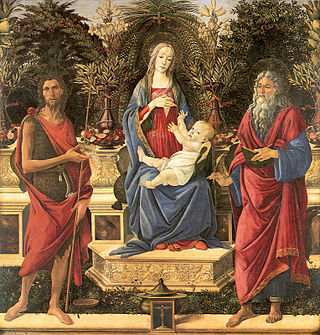
The Bardi Madonna or Madonna and Child with Saint John the Baptist and Saint John the Evangelist is a 1480s tempera-on-panel painting by Sandro Botticelli, now in the Gemäldegalerie, Berlin. Its primary name derives from the rich Florentine banker Agnolo Bardi, who commissioned it for his family chapel at the Santo Spirito Basilica in Florence. It was completed around the end of 1485.


















